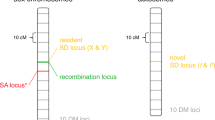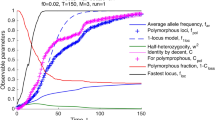Abstract
The modern theory of speciation assigns a prominent role to the recessivity of genetic incompatibilities in the two rules of speciation, namely Haldane's rule and the ‘large X effect’, and considers that the contribution of faster evolution of the X versus the autosomes to those patterns is generally of relatively minor importance. By extending Turelli and Orr's previous analysis of the model of two-locus Dobzhansky–Muller incompatibilities, I first show that when the X and the autosomes evolve at the same rate, the two dominance parameters involved in that model are not equally important for the declaration of a large X effect, but that the degree of recessivity of homozygous–homozygous incompatibilities is the major determinant for such a declaration. When the X evolves faster than the autosomes, the model obviously predicts that the importance of both dominance parameters will progressively vanish. It is then of importance to obtain estimates of the relative evolutionary rate of X-linked incompatibility loci. Several different procedures to obtain such estimates from the perspective of the large X effect are suggested. The application of the appropriate test to the only suitable data from Drosophila hybridizations so far available leads to the conclusion that the X actually evolves at least 2.5 times faster than the autosomes, as far as hybrid male sterility determinants are concerned, thus making dominance considerations absolutely irrelevant. Notwithstanding the necessity of further tests, the relative roles currently assigned to faster-X evolution and dominance in the theory of speciation should be revised, giving due prominence to faster-X evolution, at least for hybrid male sterility in the genus Drosophila.
Similar content being viewed by others
References
Ashburner, M., 1989. Drosophila: A Laboratory Handbook. Cold Spring Harbor Laboratory Press, Cold Spring Harbor, NY.
Bauer, V.L. & C.F. Aquadro, 1997. Rates of DNA sequence evolution are not sex-biased in Drosophila melanogaster and D. simulans. Mol. Biol. Evol. 14: 1252–1257.
Begun, D.J. & P. Whitley, 2000. Reduced X-linked nucleotide polymorphism in Drosophila simulans. Proc. Natl. Acad. Sci. USA 23: 5960–5965.
Bordenstein, S.R. & M.D. Drapeau, 2001. Genotype-byenvironment interaction and the Dobzhansky-Muller model of postzygotic isolation. J. Evol. Biol. 14: 490–501.
Charlesworth, B., J.A. Coyne & N.H. Barton, 1987. The relative rates of evolution of sex chromosomes and autosomes. Am. Nat. 130: 113–146.
Coyne, J.A., 1984. Genetic basis of male sterility in hybrids between two closely related species of Drosophila. Proc. Natl. Acad. Aci. USA 81: 4444–4447.
Coyne, J.A., 1985. The genetic basis of Haldane's rule. Nature 314: 736–738.
Coyne, J.A. & H.A. Orr, 1989. Two rules of speciation, pp. 180–207 in Speciation and its Consequences, edited by D. Otte & J.A. Endler. Sinauer Associates, Sunderland, MA.
Dobzhansky, T., 1937. Genetics and the Origin of Species. Columbia University Press, NY.
Graves, J.A.M. & M.L. Delbridge, 2001. The X - a sexy chromosome. BioEssays 23: 1091–1094.
Haldane, J.B.S., 1922. Sex-ratio and unidirectional sterility in hybrid animals. J. Genet. 12: 101–109.
Hollocher, H. & C.-I. Wu, 1996. The genetics of reproductive isolation in the Drosophila simulans clade: X vs. autosomal effects and male vs. female effects. Genetics 143: 1243–1255.
Hurst, L. & J.P. Randerson, 1999. An exceptional chromosome. Trends Genet. 15: 383–385.
Jablonka, E. & M.J. Lamb, 1998. Epigenetic inheritance in evolution. J. Evol. Biol. 11: 159–183.
Jiggins, C.D., M. Linares, R.E. Naisbit, C. Salazar, Z.H. Yang & J. Mallet, 2001. Sex-linked hybrid sterility in a butterfly. Evolution 55: 1631–1638.
Laurie, C.C., 1997. The weaker sex is heterogametic: 75 years of Haldane's rule. Genetics 147: 937–951.
Lifschytz, E. & D.L. Lindsley, 1974. Sex chromosome activation during spermatogenesis. Genetics 78: 323–331.
Lindsley, D.L. & E. Lifschytz, 1972. The genetic control of spermatogenesis in Drosophila, pp. 203–222 in Proceedings of the International Symposium on the Genetics of the Spermatozoon, edited by R.A. Beatty & S. Gluecksohn-Waelsch. University of Edinburgh, Edinburgh.
Lindsley, D.L. & K.T. Tokuyasu, 1980. Spermatogenesis, pp. 226–294 in The Genetics and Biology of Drosophila, edited by M. Ashburner & T.R.F. Wright. Academic Press, NY.
Muller, H.J., 1940. Bearing of the Drosophila work on systematics, pp. 185–268 in The New Systematics, edited by J. Huxley. Clarendon Press, Oxford.
Muller, H.J., 1942. Isolating mechanisms, evolution and temperature. Biol. Symp. 6: 71–125.
Orr, H.A., 1993. A mathematical model of Haldane's rule. Evolution 47: 1606–1611.
Orr, H.A., 1995. The population genetics of speciation: the evolution of hybrid incompatibilities. Genetics 139: 1805–1813.
Orr, H.A., 1997. Haldane's rule. Annu. Rev. Ecol. Syst. 28: 195–218.
Orr, H.A. & A. Betancourt, 2001. Haldane's sieve and adaptation from the standing genetic variation. Genetics 157: 875–884.
Orr, H.A. & L.H. Orr, 1996. Waiting for speciation: the effect of population subdivision on the time to speciation. Evolution 50: 1742–1749.
Presgraves, C.C. & H.A. Orr, 1998. Haldane's rule in taxa lacking hemizygous X. Science 282: 952–954.
Prowell, D.P., 1998. Sex linkage and speciation in Lepidoptera, pp. 309–319 in Endless Forms: Species and Speciation, edited by D.J. Howard & S.H. Berlocher. Oxford University Press, Oxford.
Reinhold, K., 1998. Sex linkage among genes controlling sexually selected traits. Behav. Ecol. Sociobiol. 44: 1–7.
Saifi, G.M. & H.S. Chandra, 1999. An apparent excess of sex-and reproduction-related genes on the human X chromosome. Proc. Royal Soc. Lond. B 266: 203–209.
Ting, C.-T., S.-C. Tsaur, M.-L. Wu & C.-I. Wu, 1998. A rapidly evolving homeobox at the site of a hybrid sterility gene. Science 282: 1501–1504.
Ting, C.-T., S.-C. Tsaur & C.-I.Wu, 2000. The phylogeny of closely related species as revealed by the genealogy of a speciation gene, Odysseus. Proc. Natl. Acad. Sci. USA 97: 5313–5316.
True, J.R., J.M. Mercer & C.C. Laurie, 1996. Differences in crossover frequency and distribution among three sibling species of Drosophila. Genetics 142: 507–523.
True, J.R., B.S. Weir & C.C. Laurie, 1996. A genome-wide survey of hybrid incompatibility factors by the introgression of marked segments of Drosophila mauritiana chromosomes into Drosophila simulans. Genetics 142: 819–837.
Turelli, M., 1998. The causes of Haldane's rule. Science 282: 889–891.
Turelli, M. & D.J. Begun, 1997. Haldane's rule and X-chromosome size in Drosophila. Genetics 147: 1799–1815.
Turelli, M. & H.A. Orr, 1995. The dominance theory of Haldane's rule. Genetics 140: 389–402.
Turelli, M. & H.A. Orr, 2000. Dominance, epistasis and the genetics of postzygotic isolation. Genetics 154: 1663–1679.
Wang, P.J., J.R. McCarrey, F. Yang & D. Page, 2000. An abundance of X-linked genes expressed in spermatogonia. Nature Genet. 27: 422–426.
Wu, C.-I., N.A. Johnson & M.F. Palopoli, 1996. Haldane's rule and its legacy: why are there so many sterile males? TREE 11: 281–284.
Author information
Authors and Affiliations
Rights and permissions
About this article
Cite this article
Naveira, H.F. On the Relative Roles of Faster-X Evolution and Dominance in the Establishment of Intrinsic Postzygotic Isolating Barriers. Genetica 118, 41–50 (2003). https://doi.org/10.1023/A:1022978222021
Issue Date:
DOI: https://doi.org/10.1023/A:1022978222021




